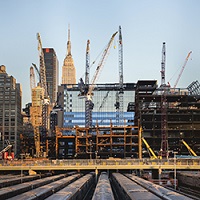The remnants of the economic boom period of the 40’s and 50’s are everywhere. Across the U.S. some of the largest metropolises have left enormous wastelands of former factories, warehouses, and industrial sites to rot. Today, there is a rebirth of industrial sites taking place to the benefit of both investors and the communities where these sites are located.
Once Thriving Business Centers
Almost a century ago, the site of the old Union Stock Yards in Chicago was the epicenter of a thriving business district full of manufacturing plants and warehouses. In fact, it was one of the first “planned industrial parks in the U.S.” In its hey-day this industrial area housed over 250 different businesses on top of over a half a million square feet of commercial space.
Originally a military facility built back in 1918, for decades now it has been a massive blot on the landscape of the area. That is until the landmark district was added to the endangered list in 2014. That drew the attention of a non-profit in Chicago looking to give the hundred year old industrial site a rebirth, turning it into a new manufacturing hub on Chicago’s South Side.
Like many of these outdated and uninhabited industrial sites, the bones or structure of these buildings is solid. It, like many others, is located in a highly desirable location near the heart of the city making it a viable place to build new offices and transportation centers which will bring new tenants and residents back to the area.
When Industrial Communities Died
What happened to the communities when these industries shuttered their doors is many residents did the same. Looking for better paying jobs which were leaving the urban centers for the exurbs and suburbs, population flight drained the cities of their economic powerhouses and the communities reflect that loss.
The result of decades of this is thousands and thousands of what are called “dead zones” throughout the U.S. where there are few jobs and even less investment in the area. In its place came crime, deteriorating schools, lost opportunities, and a shrinking tax base.
Over time the economy changed andthe way businesses built and housed their companies changed. No longer are huge brick and steel buildings that take up hundreds of thousands of square feet of space necessary for manufacturing. Finding the space to build new offices that house hundreds, if not thousands, of employees is as difficult as financing new construction of such an office.
But as the economic and housing collapse forced businesses to shrink their payrolls, the need to maximize dollars and reel in spending necessitated new ways of imagining the modern workspace. With that, commercial real estate agents and developers began looking at these antiquated behemoths in a new light.
Instead of thinking of pitching one of these huge parks to a sole buyer, why not transform it into a multi-purpose center where each building on the campus can be a different business, and those six and ten story cinderblock monuments can be converted into residential properties housing hundreds of people bringing rebirth and revitalization to once proud and profitable communities.
Why Industrial Sites are So Attractive
When you consider all of the pluses that come with these industrial sites it’s hard to imagine that the idea of redeveloping these areas hadn’t been thought of before. A lot of these conveniences you just can’t find anywhere else, at least not at the price per square foot that you can find with these former industrial sites, including:
- Convenient access to city sewage and water
- Enough electricity to power large centers
- Located close to city centers
- Solid building foundations and structure
- Versatile and adaptable to countless uses
Think about the era when these industrial sites were built. Often they were located close to where workers lived. When these sites were built, that meant the heart of the city since there were no suburbs to speak. Often, like with the Chicago Union Stock Yards, they are situated near convenient public transportation.
And because they were often used for manufacturing, many of the utilities that you need to operate these large facilities are already installed including, for instance, water delivery systems and enough electrical power to operate a large manufacturing plant.
Future business growth in an industrial park is much easier to do. You won’t have to look for larger facilities outside of your redeveloped business park. Expansion can happen by adding additional areas of the complex or moving to larger areas on the same site.
Aesthetically, the industrial look is a new appealing trend for businesses and millennial aged homebuyers. While preserving the historical importance of these buildings, you can also appeal to younger buyers who are looking for high rise luxury condos conveniently located in the heart of the city. They love the wide open floor plan concept that an old warehouse makes possible. The high industrial height ceilings are excellent for production studios, bars, restaurants, and many other enterprises.
Modern Day Uses for Old Industrial Sites
There is really no limit to what these old industrial sites can become in their modern day reinvention. Many developers in areas like NYC and California where residential space is limited, are turning these industrial sites into apartment buildings and condominiums.
But an even bigger trend even in those cities is to replace those buildings zoned only for industrial use into mix-use sites. These projects are what have investors, developers, and commercial real estate agents so excited. In one former industrial site, you can have:
- Restaurants
- Apartments and Condos
- Retail Stores
- Business Offices
- Entertainment Venues
- Medical Facilities
- Spa Centers
- Nail Shops
- And Much More
On top of that, these buildings make the perfect site for new shared workspace models where a group of businesses rent the same space, cutting much of their overhead costs. This helps small and mid-sized startups save on costs while they build their businesses up.
Capitalizing on the new business generated by the other companies in the same park, startups have a much better chance of being noticed, further aiding their growth. When local businesses thrive, so does the community that they service which in turn attracts more new businesses and thus more new residents.
Places with Redeveloped Industrial Real Estate Space
Detroit: The former auto industrial complexes of Detroit look to remake this city anew by redeveloping their industrial sites into retail and small-scale manufacturing space.
NYC: Recently ranked as the top location for industrial site rebirth, the Lower Hudson Valley, Yonkers, Westchester, and even Manhattan are just some of the places in the world metropolis of New York converting old office buildings and warehouses into new housing.
Massachusetts: An old mill built in the 1800s is now a cultural arts center and museum in North Adams and Boston is converting some of its industrial space to accommodate new residents by building new luxury condos near the heart of the city.
NJ: In New Jersey, an old cookie manufacturing plant that was shuttered a decade ago is now being redeveloped into an apartment complex big enough to house over a hundred residents. Harrison, N.J. has plans to redevelop all of their old industrial parks (around 250 acres worth) into hotels, condos, apartments, grocery stores, and more parking.
Denver: One of the biggest industrial site rebirths is taking place in Denver, Colo. where an old airport is expected to house up to 10K residents on the 17 million square feet of space over the 4,700-acre industrial site by 2030.
PA: Pennsylvania’s industrial site rebirth is happening all over the state with a 40K sq.ft. warehouse being transformed into a sports center in Allentown, while city developers working with new business and community groups look to actually use the green energy revolution to bring manufacturing back to their old manufacturing hubs.
You Can Help this Rebirth
As a commercial real estate agent, prospective investors and buyers are looking to you to help them find the right properties to invest in. While there are a lot of pluses to this industrial site rebirth, there are some cautions to think about including location for some, zoning laws for others, and the costs to bring some of these old buildings up to code.






